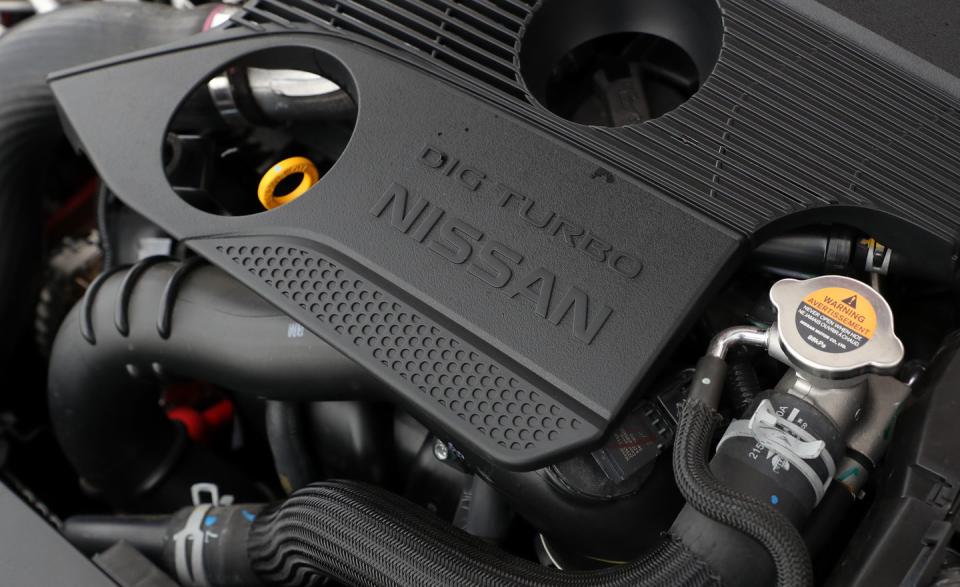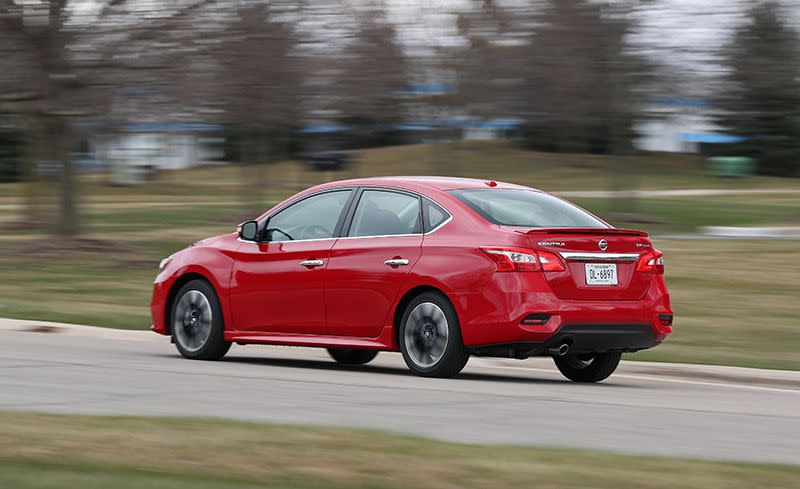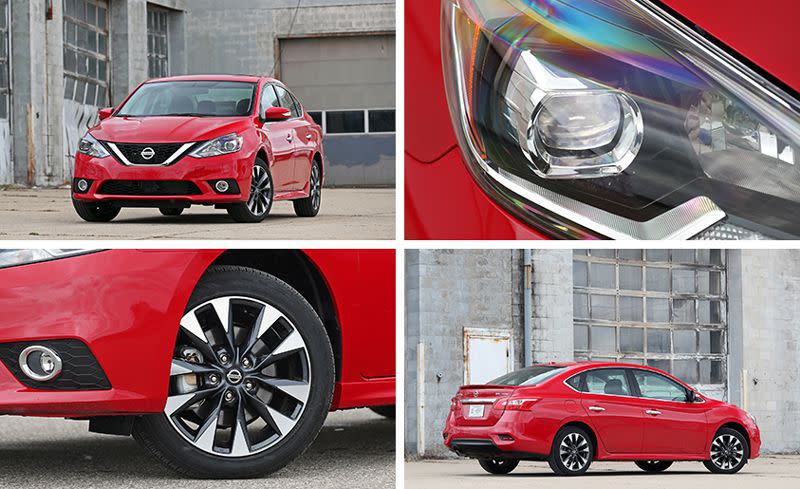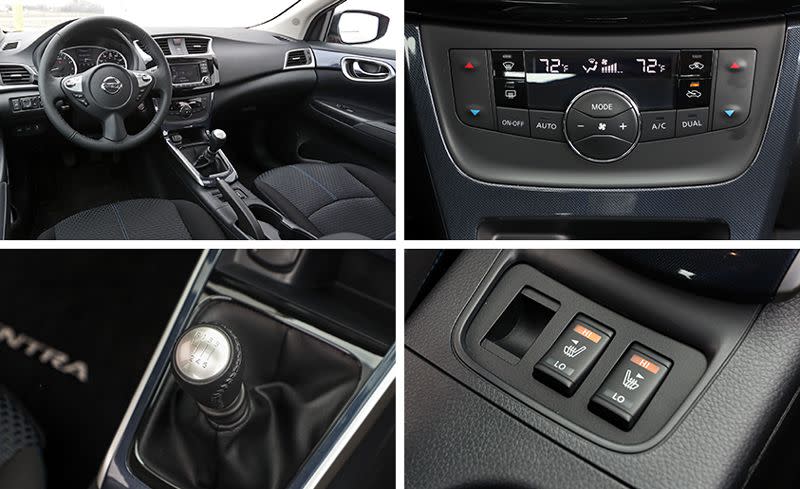Nissan Sentra SR Turbo Tested: A Sentra Intelligence Dossier
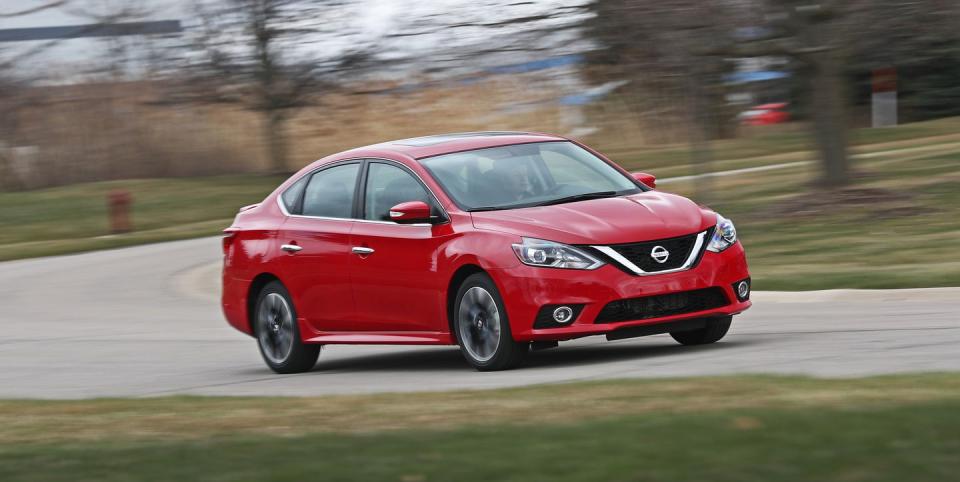
An entertaining powertrain does not always result in an entertaining car. Case in point: the 2018 Nissan Sentra SR Turbo. In spite of its quite good forced-induction inline-four, this Sentra isn’t quite a competitive sport compact.
Positioned between the $21,385 Sentra SR and the $26,675 Sentra NISMO, the $23,085 SR Turbo shares its styling with the SR but pulls its engine and standard six-speed manual gearbox from the NISMO. A continuously variable automatic transmission (CVT) is a $290 option. The Sentra SR Turbo may look like a sheep, but under its stubby hood rests the heart of a fiercer beast.
Juke Box Hero
Although Nissan began offering its turbocharged 1.6-liter four-cylinder in the Sentra only last year, the 188-hp engine’s roots go back to the 2011 Nissan Juke subcompact crossover SUV. Despite its age, the small-displacement four feels capable of competing with similarly sized turbo engines from the likes of Honda and Volkswagen. It’s a shame Nissan doesn’t install this engine in more of its products.
Compared with the Sentra’s standard naturally aspirated 1.8-liter inline-four, which produces 130 horsepower when paired with the six-speed manual in the base Sentra S and 124 ponies when coupled to the CVT that’s standard on SV and SR models, the forced-induction four-banger might as well be Usain Bolt. This SR Turbo scooted to 60 mph in a reasonable-enough 7.0 seconds (identical to a Civic Sport manual and a few tenths slower than a VW Golf manual) and crossed the quarter mile after 15.4 seconds at 94 mph. A Sentra with the 1.8-liter engine and the CVT needed 9.5 and 17.4 seconds at 81 mph to accomplish both tasks.
While the SR Turbo accelerates with relative haste, the Nissan lacks the polish of rivals such as the Honda Civic 1.5T and the Mazda 3 2.5L whose available manual gearboxes are more rewarding to operate. Where the sticks in the Honda and Mazda move from gate to gate with solid heft, the Nissan’s lever falls into gear with a hollow thud. The cog-swapping courtship between operator and machine is further muddled by a feather-light clutch with a high engagement point, and the engine has a tendency to hang onto revs with almost every release of the clutch.
Despite its lack of tactile refinement, the transmission’s short throws and well-spaced ratios make it easy to take advantage of the engine’s healthy 177 lb-ft of torque available from 1600 to 5200 rpm. A short final-drive ratio (4.44:1) provides additional accelerative assistance at speed, although it does result in noticeable engine drone during sustained highway cruising as the crankshaft spins at close to 3000 rpm. Even so, the SR Turbo allowed only an Audi A4–like 68 decibels of noise into the cabin at 70 mph.
The Nissan also returned 33 mpg on our 75-mph highway fuel-economy test-1 mpg better than its EPA highway rating. We averaged 28 mpg throughout the entirety of the car’s stay, matching the EPA’s combined estimate.
Less Than Expected
Along with its powertrain improvements, the SR Turbo includes additional dynamic enhancements such as a revised power steering system, 10-percent-stiffer front springs, revised front and rear dampers, and 0.6-inch-larger front brake rotors. The suspension changes are a welcome addition that provide the SR Turbo with a more refined ride than its naturally aspirated counterpart.
Operate the SR Turbo with any sense of vigor, though, and the 3020-pound sedan will protest like a small child forced to eat broccoli. Body roll is prominent, understeer is imminent, and the light steering rack is as informative as a White House press briefing.
Coming to a stop from 70 mph ate up 180 feet of tarmac, 11 feet shorter than the naturally aspirated Sentra but 24 feet longer than what we recorded from a Sentra NISMO. Skidpad grip of 0.85 g is roughly on par with the standard Mazda 3 and VW Golf, but short of what we’ve measured for competing models with sporting pretensions such as the Honda Civic Sport and Hyundai Elantra Sport.
Original Sin
The most heinous crimes of the Sentra SR Turbo occur inside the car. Like all Sentras, the SR Turbo suffers an inability to cater to drivers of above-average height. Headroom is at a premium, the front-seat bottoms are too short for proper thigh support, the lateral bolstering is lacking, and the steering column’s telescoping range is so limited we question why Nissan even bothered adding the function at all.
At least the dashboard controls are intuitive and ergonomically arranged, even if the center-mounted 5.0-inch touchscreen infotainment display and dual-zone automatic climate controls look a decade old. The back seat is impressively spacious, and the 182.5-inch long sedan also includes a rather large 15-cubic-foot trunk. A 60/40 split-folding rear seat offers additional versatility, but the seatbacks don’t fold flat with the cargo-area floor, which can make loading longer items a bit more difficult.
However, the final nail in the 2018 Nissan Sentra SR Turbo’s coffin is its price, which is $490 greater than a similarly equipped Honda Civic EX-T sedan and $600 more than a comparable Mazda 3 2.5L Touring sedan (both equipped with a manual transmission). It’s also $400 more than the 201-hp Hyundai Elantra Sport. While its powertrain may be likable enough on its own, the Sentra SR Turbo as a whole can’t compete when more engaging and more comfortable competitors can be had for less.
You Might Also Like

 Yahoo Autos
Yahoo Autos 